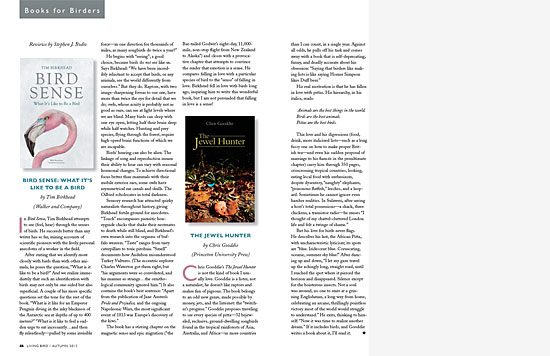Book Review: Bird Sense, by Tim Birkhead
Reviewed by Stephen J. Bodio
October 15, 2012
In Bird Sense, Tim Birkhead attempts to see (feel, hear) through the senses of birds. He succeeds better than any writer has so far, mixing accounts of scientific pioneers with the lively personal anecdotes of a worker in the field.
After stating that we identify more closely with birds than with other animals, he poses the question, “What is it like to be a bird?” And we realize immediately that such an identification with birds may not only be one-sided but also superficial. A couple of his more specific questions set the tone for the rest of the book. “What is it like for an Emperor Penguin diving in the inky blackness of the Antarctic sea at depths of up to 400 meters?” “What is it like to feel a sudden urge to eat incessantly. . .and then fly relentlessly—pulled by some invisible force—in one direction for thousands of miles, as many songbirds do twice a year?”
He begins with “seeing”; a good choice, because birds do not see like us. Says Birkhead: “We have been incredibly reluctant to accept that birds, or any animals, see the world differently from ourselves.” But they do. Raptors, with two image-sharpening foveas to our one, have more than twice the eye for detail than we do; owls, whose acuity is probably not as good as ours, can see at light levels where we are blind. Many birds can sleep with one eye open, letting half their brain sleep while half watches. Hunting and prey species, flying through the forest, require high-speed brain functions of which we are incapable.
Birds’ hearing can also be alien. The linkage of song and reproduction means their ability to hear can vary with seasonal hormonal changes. To achieve directional focus better than mammals with their mobile exterior ears, some owls have asymmetrical ear canals and skulls. The Oilbird echolocates in total darkness.
Sensory research has attracted quirky naturalists throughout history, giving Birkhead fertile ground for anecdotes. “Touch” encompasses parasitic honeyguide chicks that shake their nestmates to death while still bind, and Birkhead’s own research into the orgasms of buffalo weavers. “Taste” ranges from tasty caterpillars to toxic pitohuis. “Smell” documents how Audubon misunderstood Turkey Vultures. (The eccentric explorer Charles Waterton got them right, but “his arguments were so convoluted, and his manner so strange. . .the ornithological community ignored him.”) it also contains the book’s best sentence: “Apart from the publication of Jane Austin’s Pride and Prejudice, and the ongoing Napoleonic Wars, the most significant event of 1813 was Europe’s discovery of the kiwi.”
The book has a stirring chapter on the magnetic sense and epic migration (“the Bar-tailed Godwit’s eight-day, 11,000-mile, non-stop flight from New Zealand to Alaska”) and closes with a provocative chapter that attempts to convince the reader that emotion is a sense. He compares falling in love with a particular species of bird to the “sense” of falling in love. Birkhead fell in love with birds long ago, inspiring him to write this wonderful book, but I am not persuaded that falling in love is a sense!

All About Birds
is a free resource
Available for everyone,
funded by donors like you
American Kestrel by Blair Dudeck / Macaulay Library





